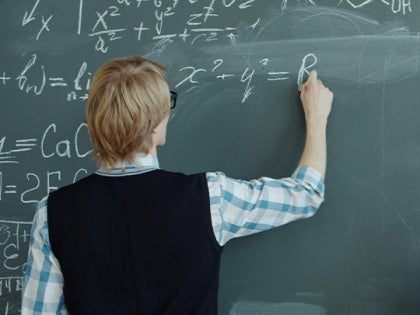Mathematics and Statistics
Mailing Address
Cleveland State University
Mathematics & Statistics
2121 Euclid Ave., MTH
Cleveland, OH 44115-2214
Campus Location
Rhodes Tower (RT)
1860 E. 22nd Street, Rm. 1515
Contact Us
Phone: 216.687.4680
mathematics@csuohio.edu
Mathematics (B.S., B.A.)

Program Description
The Math Department offers the Bachelor of Arts (B.A.) degree and the Bachelor of Science (B.S.) degree in mathematics. The mathematics requirements for the two degrees are identical; the difference between them is the number of science credits that are required.
Mathematicians use theory, computational techniques, algorithms and computer technology to solve problems in various fields, including basic sciences, engineering, computer science, economics, business, finance, and social sciences. The study of mathematics is traditionally divided into pure (theoretical) mathematics, which involves discovering new mathematical principles and relationships, and applied mathematics, which develops mathematical techniques for solving practical problems. Statistics is a sub-field of applied mathematics that focuses on data analysis.
What skills are developed within this major?
Employers in technology, science, research, finance, insurance, manufacturing, government and other areas want to hire mathematics majors because they can use modeling, problem-solving and critical thinking skills to find solutions to complex problems (see American Mathematical Society-careers info for more information). Skills developed in this major include:
- Analytical skills
- Ability to construct logical arguments
- Ability to perform computer-aided computations
- Ability to think outside the box
- Communication skills
- Problem solving skills
- Quantitative reasoning
- Writing skills
For many careers in the business, entrepreneurship, government, industry and non-profit sectors, a bachelor’s degree in mathematics or statistics is the entry-level qualification. Some careers in mathematical or statistical fields require more advanced or more specialized background. These careers might include research associates, statisticians, and operations research specialists, whose work involves making decisions in managing money, materials, inventory, scheduling, pricing, facilities, people, and other issues that various organizations face. For these more specialized careers, the entry-level qualification may be a master’s degree in mathematics or statistics. Typical job titles of graduates with mathematics or statistics degrees include:
- Actuary
- Cryptographer
- Data Scientist
- Investment Analyst
- Operations Research Analyst
- Numerical Analyst
- Professor
- Secondary Mathematics Teacher
- Software Engineer
- Data Analyst
The U.S. Bureau of Labor Statistics indicates there were 34,600 mathematicians and statisticians employed across the United States in 2024. On average, about 2,700 openings for mathematicians and statisticians are projected each year. There is great demand for mathematicians and statisticians, as the U.S. Bureau of Labor Statistics projects an 8% increase from 2024-2034, much faster than average for all occupations.
The department offers the Bachelor of Arts (B.A.) degree and the Bachelor of Science (B.S.) degree in mathematics. The mathematics requirements for the two degrees are identical; the difference between them is the number of science credits that are required (see below: B.A., B.S.). We have provided a degree map for students pursuing B.A./B.S. in Mathematics.
Emphases Within the Major
By carefully choosing upper-division MTH and STA electives, it is easy to focus your major with a view to a particular career or area of further study. Possible areas of emphasis within the major include: actuarial mathematics; applied and computational mathematics; pure (or theoretical) mathematics; statistics; secondary teacher licensure.
Actuarial Mathematics
Actuaries study problems of insurance and finance using mathematical and statistical modeling. A career as an actuary is consistently rated one of the top careers in the U.S. Professional certification requires passing a demanding set of exams.
Applied and Computational Mathematics
This area emphasizes the use of mathematical modeling and analysis to solve real-world problems in areas such as engineering, biology, finance and industry.
Pure (or Theoretical) Mathematics
This area emphasizes fundamental structures of mathematics and their rigorous, logical development. Ideas from pure mathematics often form a rigorous underpinning of ideas used in applied mathematics.
Statistics
This area emphasizes the analysis, interpretation and presentation of data. Statisticians and analysts are in high demand in many sectors of the economy. While any STA course, as well as MTH432, will help strengthen your statistical background and knowledge, combining a statistics minor with your mathematics major is the clearest way of emphasizing your statistics background.
Second Major for Computer Science Students
Students in the CS program, who choose a concentration in mathematics can, by suitably choosing electives and with a few additional credits in mathematics, complete all mathematics requirements for the Bachelor of Science degree with a major in mathematics. See your Computer Science Department Adviser and an adviser in the Department of Mathematics and Statistics for further information.
Secondary Teacher Licensure
The CSUteach Program offers licensure programs in mathematics and physics with a BA or BS in mathematics. The licensure program requires coursework from the College of Arts and Sciences and the College of Public Affairs and Education. Contact the CSUteach Program for education courses required for undergraduate and Post-Baccalaureate Secondary Teacher Licensure programs (216-687-4625, JH 170).
Honors Program/University Scholars Requirements
A University Honors/Scholars Program student will be able to graduate with Honors in Mathematics by completing the general requirements of the Honors or University Scholars Program and all of the following:
- Satisfy all requirements for the mathematics major (B.S. or B.A.);
- Complete two 400-level MTH (or STA 424) Honors Contract courses, for a total of 6 honors credits. These must be chosen from courses that count toward a math degree. These courses may be counted toward the major as well.
- In place of MTH 496 - Senior Project, complete MTH 496H - Honors Project (3 credits) with a C or better. The requirements for this course include all the requirements of MTH 496 plus an oral presentation of the student’s work.
Accelerated Master's Program
Through the BA+MS or BS+MS program, students may complete a BA or BS with a Master of Science degree. High performing undergraduate students may apply to the program after the second year of undergraduate study and, if accepted, complete bachelor’s and master’s coursework during the third, fourth and fifth year.
Learn more about the Accelerated Master's Program here
Learn more about the BS/BA Mathematics program and admissions requirements
Dr. Shawn Ryan
Advisor for MTH/STA Majors and Minor
Office: RT 1538
Email: s.d.ryan@csuohio.edu
Advising Appointments can be made through Starfish or via email.
There are a variety of scholarships available for incoming freshman and transfer students. Please see details below about how to apply for these scholarships. We also provide a Roadmap to Financial Aid that simplifies the process. Students are encouraged to fill out the FAFSA form for consideration of all types of financial aid.
Learn more about scholarships here
Learn more by requesting information or contacting a program staff member directly.
Program Director
Dr. Shawn Ryan
Undergraduate Program Director
Office: RT 1538
Email: s.d.ryan@csuohio.edu
Mailing Address
Cleveland State University
Mathematics & Statistics
2121 Euclid Ave., MTH
Cleveland, OH 44115-2214
Campus Location
Rhodes Tower (RT)
1860 E. 22nd Street, Rm. 1515
Contact Us
Phone: 216.687.4680
mathematics@csuohio.edu





